
The Best of the 49th San Francisco International Film Festival
April 20-May 4, 2006
The San Francisco International Film Festival is the oldest festival in the Americas. In the year before this carnival of cinemas marks its 50th anniversary, a new Executive Director, Graham Leggat, promised a fresh vision during the 15-day celebration of films--and throughout the coming year as well with its 360 Degree Program of ongoing events. The 227 films from 41 countries, including 71 feature films and 23 documentaries, more than delivered on that promise.
Tilda Swinton
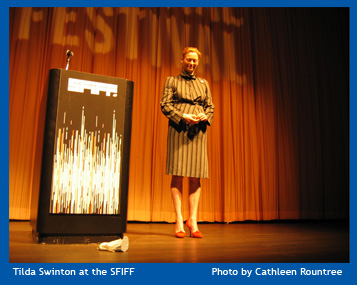 One of the highlights of the festival occurred on Saturday afternoon, April 29, when the British actress Tilda Swinton (known for her long association with the late director Derek Jarman--Caravaggio, Wittgenstein, Blue, etc.) delivered the "State of Cinema" declaration to a full house. Swinton (dressed in a school-marmish stripped suit that was in stark contrast to her vertiginous-inducing flame-red spike heels), creatively wrote her statement as if it were an open letter to her nine-year-old son (albeit an extremely sophisticated nine-year-old), who had asked her "about the current state of cinema." Her erudite speech would have made her professors at Cambridge (from where she graduated with a double major in the early 1980s) proud. Here is a brief excerpt from her thirty-minute long speech. One of the highlights of the festival occurred on Saturday afternoon, April 29, when the British actress Tilda Swinton (known for her long association with the late director Derek Jarman--Caravaggio, Wittgenstein, Blue, etc.) delivered the "State of Cinema" declaration to a full house. Swinton (dressed in a school-marmish stripped suit that was in stark contrast to her vertiginous-inducing flame-red spike heels), creatively wrote her statement as if it were an open letter to her nine-year-old son (albeit an extremely sophisticated nine-year-old), who had asked her "about the current state of cinema." Her erudite speech would have made her professors at Cambridge (from where she graduated with a double major in the early 1980s) proud. Here is a brief excerpt from her thirty-minute long speech.
...your question, and its hypnotic effect on me, inspired me to talk about none of these things, but to meditate on something I think is far more important than all of this, and much more difficult to address. You make me want to talk about what cinema is and why we need it, and what it is that is incorruptible-unco-optable-within its realm. About the state of mind, the projection of vision, the social project that cinema is and why it's worth the fight in the first place. And why no revolution, digital or otherwise, could cheat your generation out of its existence. And why I am hopeful to my boots that it's never, ever going away.
Special Ceremonies
There were several special festival ceremonies. Two of the most highly prized tickets were for the awards ceremonies celebrating two of cinemas outstanding contributors. On Wednesday, April 26 at The Castro Theatre, German director Werner Herzog (Aguirre, the Wrath of God, 1972; The Enigma of Kaspar Hauser, 1974; Woyzeck, 1978; Fitzcaraldo, 1982) received the Film Society Directing Award. Werner Herzog has been a major figure in world cinema for nearly four decades, since the late 1960s. In 2005 alone, Herzog released four documentaries, including the Oscar-snubbed Grizzly Man. The director's latest film, The Wild Blue Yonder, according to Herzog "an almost unclassifiable sci-fi fantasia," received its West Coast premiere that evening.
This year, the Peter J. Owens Award, which honors an actor whose work exemplifies brilliance, independence, and integrity, went to Ed Harris (Sweet Dreams, 1985; Glengarry Glen Ross, 1992; The Truman Show, 1998; Pollack, 2000; The Hours, 2002). According to Jason Sanders, "When directors mention Ed Harris, they skip the common phrases and use more meaningful language. 'There's just an integrity you trust; he's always truthful and interesting,' noted Ron Howard after the filming of Apollo 13, 1995)." After an interview with Harris, again at The Castro, on Friday, April 28, the festival screened a favorite film of Harris', A Flash of Green (Victor Nunez, 1984).
Outstanding Narrative Films
 In terms of the outstanding narrative feature films, which have or will eventually make their way into theatres, look for the following: Brothers of the Head (Aug. release date), a bizarre, but compelling "mockumentary" based on Brian Aldiss's 1977 novel about a legendary 1970s-era British proto-punk band Bang Bang and the conjoined twins who led it, until drug abuse and jealousy over the same woman (literally) tore them apart. This is Keith Fulton and Louis Pepe's first feature, they co-directed the doc Lost in La Mancha about Terry Gilliam's fated attempt to make a film in 2002 about Don Quixote in Spain starring Johnny Depp. Brothers of the Head is a bit over the top, but wow, what a ride. In terms of the outstanding narrative feature films, which have or will eventually make their way into theatres, look for the following: Brothers of the Head (Aug. release date), a bizarre, but compelling "mockumentary" based on Brian Aldiss's 1977 novel about a legendary 1970s-era British proto-punk band Bang Bang and the conjoined twins who led it, until drug abuse and jealousy over the same woman (literally) tore them apart. This is Keith Fulton and Louis Pepe's first feature, they co-directed the doc Lost in La Mancha about Terry Gilliam's fated attempt to make a film in 2002 about Don Quixote in Spain starring Johnny Depp. Brothers of the Head is a bit over the top, but wow, what a ride.
Without question, The Descent (Sept. release date) by British director Neil Marshall is a horror genre film that taps into the deepest primeval human fears--fear of the unknown, of the dark, of enclosed spaces, of losing control, of betrayal, of death. In addition to The Descent being a viscerally terrifying movie on the order of Hitchcock's Psycho, Alien, and The Silence of the Lambs, the film works on many levels: historical, psychological, mythological, existential. The story follows a group of young women planning a caving expedition in the Appalachian Mountains (think: a female Deliverance). The film is filled with premonitions and forebodings as Nature assumes a lethal quality. What they discover in the cave is enough to give you nightmares for weeks. Face your fears and see The Descent, which is destined to be a cult classic. the film works on many levels: historical, psychological, mythological, existential. The story follows a group of young women planning a caving expedition in the Appalachian Mountains (think: a female Deliverance). The film is filled with premonitions and forebodings as Nature assumes a lethal quality. What they discover in the cave is enough to give you nightmares for weeks. Face your fears and see The Descent, which is destined to be a cult classic.
Solo Dios sabe (Only God Knows) was one of the special finds at this year's festival. It begins as a conventional love story about a beautiful young Brazilian woman attending school in San Diego and enmeshed in a dead-end affair with a married professor. Part romance, road trip, and spiritual voyage of self-discovery, Solo Dios sabe, is lushly photographed with a matching sensual soundtrack. The two young stars--the exhilarating Alice Braga (the niece of Sonja), who also starred in City of God as well as another current Brazilian film, The Lower City, and Diego Luna from Y tu mama tambien fame--display real chemistry. Director Carlos Bolado (who also wrote the script) worked for many years as an editor (Amores perros and Like Water for Chocolate) and this film solidifies his position as a top Mexican director.
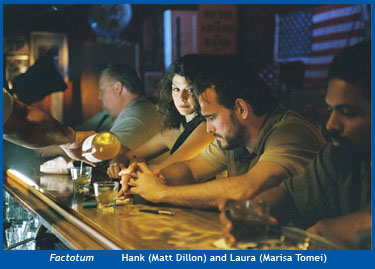 Factotum stars Matt Dillon, fresh from his gripping role in (and Oscar nod for) Crash, who portrays an unrealistically handsome Charles Bukowski, the writer/barfly upon whose 1975 novel the film is based. Norwegian Bent Hamer (director of the quirky, yet charming, Kitchen Stories) directs Dillon and his love interest Lily Taylor with a lack of sentimentality. Filmed in an appropriately lackluster section of Minneapolis, the setting reveals the characters as survivors on the fringe of society trying to connect in an indifferent world. Factotum stars Matt Dillon, fresh from his gripping role in (and Oscar nod for) Crash, who portrays an unrealistically handsome Charles Bukowski, the writer/barfly upon whose 1975 novel the film is based. Norwegian Bent Hamer (director of the quirky, yet charming, Kitchen Stories) directs Dillon and his love interest Lily Taylor with a lack of sentimentality. Filmed in an appropriately lackluster section of Minneapolis, the setting reveals the characters as survivors on the fringe of society trying to connect in an indifferent world.
Polish director Greg Zglinski's One Long Winter Without Fire (Tout un hiver sans feu) was my favorite film of the festival. Zglinski learned filmmaking at the hands of the master himself, Krzysztof Kieslowski--and it shows. Indeed, the humanist quality of Zglinski's first feature film bears the poetic pacing and imagery of his teacher as well as Kieslowski's humanism. The story begins with Jean, a farmer in the Swiss Jura mountains, who finds himself at the mercy of his insurance company after a devastating fire on his land took the life of his only child along with his dairy cows in a barn fire. Placing his ailing wife Laure in a sanatorium, Jean does his best to earn money at a blazing foundry where he meets a group of Kosovo refugees, including Labinota, who has suffered her own painful losses. The refugees bring a sense of warmth, kindness, and hope into Jean's life and, in the end, Jean must choose between his connection to the past and an opportunity for a new life. One Long Winter Without Fire should not be missed; it lingers in the viewer's memory like a glowing coal.
Other notable narrative features include: Northeast, about an affluent French woman's effort to adopt a child from a rural, impoverished region of Argentina; Look Both Ways, a cleverly-told Australian story about a comically morbid graphic artist and a photo-journalist recently diagnosed with cancer; Half Nelson, a moving and realistic look at an inner-city drug-addicted high school teacher and his unlikely friendship with a student (June release date).
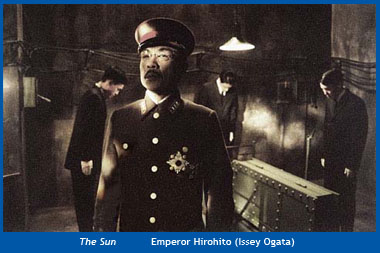 The Sun, directed by the formidable Russian director, Alexsandr Sokurov (Russian Ark, Mother and Son, Father and Son), makes cinematic history as it is the first time that Emperor Hirohito (brilliantly and empathically played by Issey Ogata) has been depicted intimately in film. The action in The Sun takes place in occupied Japan from late August 1945 until January 1946. On August 15th, Emperor Hirohito made a public appeal to his people to cease military operations. Millions of Japanese were shocked to hear their Emperor's voice for the first time in their lives. The film portrays the events leading up to two crucial decisions made by Hirohito, which were both of major historical significance. The first was the declaration of surrender from World War II, and the second was the renunciation of his divine status. During this period, the Emperor also forms an unlikely bond with the American General Douglas McArthur. Explaining the film's "character," Hirohito, Sokurov says: "The key is the depiction of the hero who suffers a personal tragedy." Sokurov's films are ever stunning to behold, but the near sepia tone quality of The Sun provides a sensory sumptuousness in an incongruously stolid and reserved environment. The fact that most of the action takes place indoors, adds to the bunker-like claustrophobia that pervades the Emperor's final days. The Sun, directed by the formidable Russian director, Alexsandr Sokurov (Russian Ark, Mother and Son, Father and Son), makes cinematic history as it is the first time that Emperor Hirohito (brilliantly and empathically played by Issey Ogata) has been depicted intimately in film. The action in The Sun takes place in occupied Japan from late August 1945 until January 1946. On August 15th, Emperor Hirohito made a public appeal to his people to cease military operations. Millions of Japanese were shocked to hear their Emperor's voice for the first time in their lives. The film portrays the events leading up to two crucial decisions made by Hirohito, which were both of major historical significance. The first was the declaration of surrender from World War II, and the second was the renunciation of his divine status. During this period, the Emperor also forms an unlikely bond with the American General Douglas McArthur. Explaining the film's "character," Hirohito, Sokurov says: "The key is the depiction of the hero who suffers a personal tragedy." Sokurov's films are ever stunning to behold, but the near sepia tone quality of The Sun provides a sensory sumptuousness in an incongruously stolid and reserved environment. The fact that most of the action takes place indoors, adds to the bunker-like claustrophobia that pervades the Emperor's final days.
Outstanding Documentaries
Many of the documentaries at this year's festival were outstanding Social Activist Cinema at its best--passionate, uncompromising and intelligent. The filmmakers are "activists," as are many of the people they film. After viewing these docs, one cannot help but ask oneself: "What can I do?"
Perhaps the most powerfully moving film of the festival was The Bridge, Eric Steel's disturbingly emotional look at Golden Gate Bridge suicides. The director included actual footage of people throwing themselves off the bridge, footage acquired during an entire year of filming from two strategically placed cameras. Steele says that his purpose in making the film is "suicide prevention and mental illness awareness," and supports the construction of a suicide barrier on the bridge's walkway. After viewing The Bridge, you will never forget this aspect of the Golden Gate.
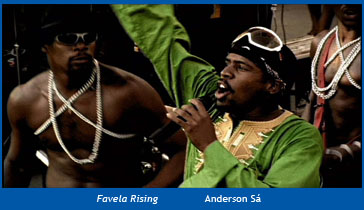 Favela Rising (summer release), directed by Americans Jeff Zimbalist and Matt Mochary, which was short-listed for this year's Oscar for Best Documentary, provides stark insights into the lives of the inhabitants of Brazil's favelas (impoverished barrios on the outskirts of Rio de Janeiro). Following on the successes of the feature film City of God, and the award-winning documentary, Bus 174, Favela Rising introduces us to the unforgettable story of Anderson Sa, a former drug dealer, turned musician and art-inspired revolutionary. His organization, Grupo Cultural AfroReggae, uses music, drumming, and dance to rally against the violence and crime that barrio youths face every day. The challenges and turns of fate that Sa overcomes are of epic proportions. His victory over personal and social despair reflects hope in a seemingly desperate situation. Favela Rising (summer release), directed by Americans Jeff Zimbalist and Matt Mochary, which was short-listed for this year's Oscar for Best Documentary, provides stark insights into the lives of the inhabitants of Brazil's favelas (impoverished barrios on the outskirts of Rio de Janeiro). Following on the successes of the feature film City of God, and the award-winning documentary, Bus 174, Favela Rising introduces us to the unforgettable story of Anderson Sa, a former drug dealer, turned musician and art-inspired revolutionary. His organization, Grupo Cultural AfroReggae, uses music, drumming, and dance to rally against the violence and crime that barrio youths face every day. The challenges and turns of fate that Sa overcomes are of epic proportions. His victory over personal and social despair reflects hope in a seemingly desperate situation.
Koyaanisqatsi-like in its montage of images (sans the kinetic pace), Workingman's Death captures manual laborers in some of the most harrowing circumstances imaginable and deconstructs contemporary conceptions of work--by showcasing six of the most grueling and dangerous professions director Michael Glawogger could find. Recent tragedies in the mines of Virginia have brought our collective attention to the substandard safety regulations miners live (and die) with. The brutally gruesome slaughter yard in Niger is definitely not for the squeamish. One can almost feel the blistering heat of a volcano basin in Kawah Ijen, Indonesia, as sulfur workers carry baskets of foul-smelling sulfur pieces down the mountain. In Gaddani, Pakistan, barehanded migrants work as ship-breakers on a seaside beach, disassembling oil carriers piece by piece. What makes this documentary so powerful is the unflinching, direct stares of the film's participants.
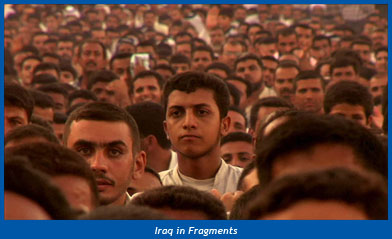 Under the constant threat of kidnapping and death, director, James Longley, lived in Iraq for more than two years. His film Iraq in Fragments illuminates post-war Iraq in three acts by building a vivid picture of a country pulled in different directions by religion and ethnicity. Filmed in cinema verite style, the film powerfully explores the lives of ordinary Iraqis: people whose thoughts, beliefs, aspirations, and concerns are at once personal and illustrative of larger issues in Iraq today. This poetic, revealing political documentary brings to life abstract images we see on television and in the newspaper everyday. Under the constant threat of kidnapping and death, director, James Longley, lived in Iraq for more than two years. His film Iraq in Fragments illuminates post-war Iraq in three acts by building a vivid picture of a country pulled in different directions by religion and ethnicity. Filmed in cinema verite style, the film powerfully explores the lives of ordinary Iraqis: people whose thoughts, beliefs, aspirations, and concerns are at once personal and illustrative of larger issues in Iraq today. This poetic, revealing political documentary brings to life abstract images we see on television and in the newspaper everyday.
Jonestown: The Life and Death of Peoples Temple, directed by Stanley Nelson, will be of particular interest to those who lived in the Bay Area in the mid-to-late 1970s, when Jim Jones brought his Peoples Temple to San Francisco, seemingly offering the perfect balance of spiritual fulfillment and political commitment. Jones not only preached about racial integration and commitment, he built an organization that provided food, clothing and shelter to his congregation and community. Utilizing never before seen archival footage and survivor interviews to tell the harrowing story, Jonestown traces the rise of the charismatic founder who, on November 18, 1978, convinced 907 men and women to feed arsenic-laced kool-aid to their children and then drink it themselves. The caveat: "Beware of false prophets" has a chilling resonance in this film.
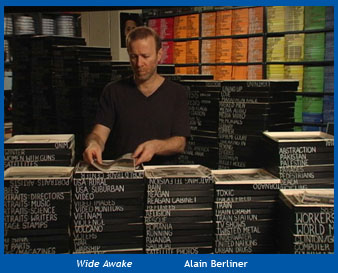 Other notable docs include: American Blackout, about the disenfranchisement of African American voters during the 2000 and 2004 elections; Who Killed the Electric Car, which will render viewers speechless with anger at the crushing of the American-designed electric car; and Wide Awake, an entertaining personal essay on the filmmaker (and compulsive archivist) Alain Berliner's battle with insomnia and how this condition permeates every facet of his existence. Other notable docs include: American Blackout, about the disenfranchisement of African American voters during the 2000 and 2004 elections; Who Killed the Electric Car, which will render viewers speechless with anger at the crushing of the American-designed electric car; and Wide Awake, an entertaining personal essay on the filmmaker (and compulsive archivist) Alain Berliner's battle with insomnia and how this condition permeates every facet of his existence.
(A version of this festival commentary appeared in the Summer 2006 issue of The San Francisco Jung Institute Library Journal.)
Home | About: Site Philosophy | About: Cathleen | About: The Book | Reviews: Current | Reviews: Archive
Purchase the book! | Festival Dispatches | The Movie Lovers' Club | Links | Contact

All text on this website copyright © 2006 Cathleen Rountree. All images and graphics copyright their respective owners, unless otherwise noted. Design by Jay Wertzler.
|
